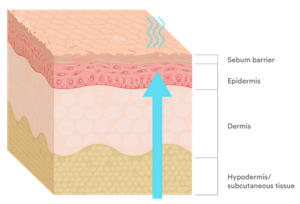Severe dry skin is more than just frustrating - it can be both painful and embarrassing as well. One of the drivers of the frustration is that there is no single cause you can peg an extremely dry skin condition to, rather, it can manifest due to a variety of factors. However, with knowledge of the potential causes and triggers, you can both treat and manage extremely dry skin with a proper skin care routine, the right products, and maybe a few changes to your routine.
Severe Dry Skin Symptoms &
Dermatologist Treatment Tips

Signs & Symptoms of Severe Dry Skin
Skin is the body’s largest organ and can range from normal to severely dry depending on a multitude of factors. Typically, extremely dry skin gradually progresses from normal to dry skin and then finally severely dry skin.
The skin has three layers. The top layer is the epidermis. The epidermis is where skin tone is determined and forms a critical waterproof barrier between our internal organs and the external environment. When dry skin issues arise, the epidermis is where the problems reside. The dermis is found beneath the epidermis and is where tougher connective tissue, hair follicles, and sweat glands are found. The third layer and deepest layer of skin is the hypodermis, or subcutaneous tissue, which is made of fat and connective tissue. These layers of the skin will look and function differently based on skin type.

Normal skin has a stronger barrier that helps lock moisture in.
Normal skin is a term used to describe skin that is well balanced- meaning it isn’t too oily or too dry. Generally, normal skin types have an even balance of sebum production, an oily and waxy matter that lubricates and waterproofs the skin’s surface.

Dry skin has a weaker barrier wich allows for moisture to easily evaporate, causing skin to feel tight and rough looking.
Dry skin occurs when skin cells produce less sebum (natural oils) than necessary. This lack of sebum results in the skin feeling tight with a dull or rough-looking texture. "That feeling of your skin being tight can happen all over your body. Wherever you have oil glands and there is less sebum being produced than necessary, your skin will feel dry and tight,"says Dr. Debra Jaliman,board-certified NYC dermatologist and Assistant Professor of Dermatology at Icahn School of Medicine at Mount Sinai.

Severely dry skin has an extremely weak barrier. Therefore moisture escapes easily, leaving the skin rough, cracked, and flaky.
Severe dry skin can feel rough, tight or itchy. It can also be identified through flaking skin, and can sometimes even crack and bleed if not treated. In skin that is severely dry, there is very little if any sebum being produced. "Ideally your skin is at its best when there is balance with sebum production. There needs to be a balance with skin's moisture," says Dr. Jaliman.
Signs of Severe Dry Skin
Roughness
Some rough skin can usually be characterized as Eczema: it can be discolored, scaly, and, for example, can even sometimes gets caught on fabrics. "This can often look like a dry rash and can appear on any part of the body. Also, Keratosis pilaris can also be red in color and have a sandpaper/rough-like texture, which can get caught on and sometimes scratch fabrics," says Dr. Todd Besnoff of Ultimate Image Cosmetic Medical Center.
Severe Itchiness
Stay away from hot showers as this will make dry skin even drier and increase the itchiness. "Thick, heavy products have more staying power and will keep water from evaporating from your skin. When the skin has lost a lot of moisture it causes that itchiness," says Dr. Jaliman. "Once you rehydrate and moisturize you will feel the itchiness start to lessen."
Slight to Severe Flaking
If your skin is starting to shed in large flakes, or you see flakes of skin on your black clothing, that is a reliable sign that your skin is severely dry and needs some additional care. "Flaking is definitely a symptom of very dry skin. To prevent this from happening we need to keep the skin hydrated. Drinking at least 7-8 glasses of water can help with keeping your body hydrated. Making sure your skin is always moisturized is very important," says Dr. Jaliman.
Dermatologist Tip: To lessen the occurrence of flaking it's important to wash well when we come from outside to remove any dirt or pollution from the surface skin. "Gently exfoliate with a washcloth. It is important that you do not scrub too hard but rather rub lightly. Even the best skin in the world will look dull if it is not exfoliated," says Dr. Jaliman.
Skin Fissures
"Skin fissures are another way of saying tiny cracks on the skin. If not treated they can become much larger cracks," says Lisa Adam, Head of R&D at Curel. "When your skin is severely dry your skin will have tiny cracks, also known as skin fissures. When skin is very dry the moisture barrier has been compromised and breaks in the skin occur" says Dr. Jaliman.
Cracked Skin
Cracking happens when skin loses its ability to hold moisture and the skin barrier is compromised. When this happens, due to the lack of moisture, skin loses its elasticity, and with stress such as stretching or moving the skin can actually break," Adams explains. Cracks on the heels or knuckles, in particular, can become especially deep and if not treated, can become infected.
Areas prone to skin cracking:
What Causes Severely Dry Skin?
Severe dry skin is caused when no or very little sebum is naturally produced by the skin, leaving the skin severely lacking in moisture. Various factors can lead to a decrease in sebum production, from genetics to an increase in a hormone called dihydrotestosterone (DHT).
Read on to learn what our experts have to say about why these factors contribute to extremely dry skin.
Environmental factors
“Environment can play a significant role in the condition of the skin," says Adams. For example, extremely cold or very dry climates have less humidity in the air—which means less natural moisture for your skin—and can ultimately lead to skin drying out harshly and quickly. In these types of environments, lotions and moisture rich creams are necessary to keep essential hydration from escaping into the environment. Moisture-rich creams will keep your skin supple and hydrated while keeping water from escaping.
The sun also plays a huge role in causing severely dry skin: Too much exposure to its UV rays causes the skin’s top layers to lose moisture and eventually turns into a sunburn. The most effective way to avoid sun damage is to apply sunscreen 15 minutes before going outside and to wear protective clothing such as hats, lightweight long-sleeve shirts, and lightweight pants. “When you don’t protect your skin from UV rays, the rays can damage skin cells. The damage done to skin cells can cause dryness and uneven skin color which can be referred to as pigmentation" says Dr. Jaliman.
Genetics
Every individual's genetic makeup is different, and specific markers determine the health of the skin barrier function.For example, atopic eczema is thought to be linked to a genetic mutation. “This shows up on a lot of infants in the first few months of life. The likelihood of childhood eczema is two to three times higher in children whose parents have it. With skin barrier function, changes in the Epidermal lipids, which are often caused by loss of water, allowing cracks and openings to develop in the stratum corneum,” says Dr. Besnoff. “This allows irritants to trigger inflammation. Lipids are important to the skin’s barrier function. The lipid barrier minimizes water loss and is essential for strong, healthy, hydrated skin. Lipids, in general, are like molecules that are not soluble in water --- things like Ceramides, fatty acids, cholesterol, waxes, and steroids.,” says Dr. Besnoff.
Diseases
Eczema is a common skin condition that can affect people of all ages. Overall, it is when patches of skin become extremely dry, itchy, red, and irritated.
Psoriasis is a noncontagious long-lasting autoimmune condition that makes skin cells replicate faster than normal. This appears on the skin in the form of red, raised skin with silvery scales. Although this can be genetically inherited other factors can also increase flare ups. These factors include sunburns, smoking and excessive drinking of alcohol. Psoriasis often appears on the knees and elbows, but can also show up on your face, scalp, neck, and feet. “High-stress levels, along with infections and certain medications, can also cause flare ups,” says Dr. Besnoff.
Diabetes is an autoimmune disease that affects the body’s ability to naturally produce insulin. When dealing with diabetes, it is important to take care of skin- especially where dryness is more common, such as hands and feet to make sure that it stays healthy and full of moisture. Insulin keeps you’re your blood sugar level from getting too high. Blood sugar changes in response to food, medications, illness, alcohol and more. When your blood sugar gets too high, yellow, red or brown patches can form on your skin. “A lot of people also develop a dark patch of itchy skin on the back of their necks or armpits, which is an indicator that you have too much insulin in your blood. Blisters, shin spots, and itchy skin can also form. It is extremely important to keep the skin hydrated and healthy when experiencing any of these signs/symptoms,” says Dr. Besnoff.
Medications
It’s also possible that severely dry skin is a side effect of a newly started medication. “Certain diuretics such as hydrochlorothiazide or furosemide, Retin-A, a topical medication prescribed for acne, and certain cholesterol or acne medications can all cause skin redness, burning, excessively dry skin, and itching. When you first use the previously mentioned medications, you actually have a reversed effect and get worse acne, initially. If you’ve noticed any sudden change in your skin following a new medication, immediately consult your doctor,” says Dr. Besnoff.
Products
Harsh soaps & detergents to clean your clothes can leave skin feeling irritated, scratchy and dried out. If you are experiencing these symptoms, look for gentle, fragrance-free soaps and detergents to help alleviate the dryness and irritation. After taking warm showers with a gentle cleanser, pat dry and use a deodorant specifically for dry and sensitive skin. Additionally, deodorants can aggravate sensitive underarms while cleaning agents can leave skin feeling dry or hot. If using such chemicals, it is best to wear gloves to protect your skin.
8 Dermatologist Tips to Soothe Severely Dry Skin
As we've explained in our article about dry skin, the most effective ways to treat dry skin is through a combination of ingredients. Similarly, treating extremely dry skin requires the inclusion of nourishing ingredients plus a few modifications to your skincare routine. We've asked Dermatologists to share their top tips to soothe severely dry skin and here's what they recommend:
Tip 1: Shower after swimming
Chlorine and other swimming pool chemicals can dry your skin very quickly, leaving skin feeling tight and uncomfortable. After spending time in the pool, hop in a warm shower for a quick rinse, use a gentle body cleanser, and pat skin dry.
Tip 2: Moisturize after showering
In the shower, the water causes skin cells to expand, which provides the optimal time for hydration. Dr. Besnoff recommends applying a body lotion as soon as you get out, a wet skin moisturizer is a perfect option because they are specially designed to work straight out of the shower, before toweling off. “When you get out of the shower and the skin is still moist it’s important to put your moisturizer on because this binds the water molecules to the outer layers of the skin,” says Dr. Jaliman.
Tip 3: Use a humidifier
If you live in a low humidity area, or harsh seasonal humidity, consider purchasing a humidifier to add moisture into the air and your skin. "When it’s dry in the environment, the moisture on your skin can evaporate in the air. Humidifiers are great for soothing cracked or itchy skin,” says Dr. Besnoff.
Tip 4: Take an oatmeal bath
If nothing else seems to be helping the dryness and itch of your skin, an oatmeal bath may be a lifesaver for your skin. “Simply blend some good ole’ oatmeal in a blender, sprinkle it in a warm bathtub, and soak for about 15-20 minutes,” says Dr. Besnoff. The blended oatmeal releases soothing beta-glucans into the bath to help soothe dry, itchy skin. “Oatmeal contains antioxidants that are great from treating most skin disorders. Oatmeal is great for cleansing your skin and locking in moisture – it also normalizes your skin’s pH,” says Dr. Besnoff.
Tip 5: Take supplements
Oils such as flaxseed and fish oil are high in essential fatty acids to help keep your skin healthy and glowing. Take as a supplement or add them to your favorite meals. “Fish oil and flaxseed vitamins help your skin maintain a smooth, flat and desirable structure,” says Dr. Besnoff.
Tip 6: Use Lotions with Glycerin
Glycerin is a humectant and is super hydrating, we recommend incorporating an ultra healing lotion that contains glycerine into your daily skincare regimen. “Glycerin works to moisturize the skin by drawing water from the air into the skin's outer layer. It generates a protective layer that helps prevent moisture loss,” says Dr. Jaliman.
Tip 7: Protect your hands when cleaning
Your hands are also easily subjected to getting dried out by harsh chemicals. So when cleaning around the house, make sure to wear a pair of gloves to help your hands avoid all of those chemicals.
Tip 8: Hyaluronic acid helps
Hyaluronic acid is used for moisturizing. “It’s super hydrating and has anti-aging properties. When used in peels and cleansers it helps to retain the skin’s moisture,” says Dr. Jaliman.
Now You Can Treat Your Severely Dry Skin in the Shower with Curel Hydratherapy Wet Skin Moisturizer!
When to see a Dermatologist to Treat Extremely Dry Skin
If symptoms are continual, you may want to consider a visit to your dermatologist. If you have never been to a dermatologist, there is no need to be nervous, just make sure you have a few questions for your dermatologist prepared. Here is what you can expect during a visit with your specialist:
Now that you know how to identify the signs of severely dry skin and the best ways to treat it, lets recap.
Key Takeaways






